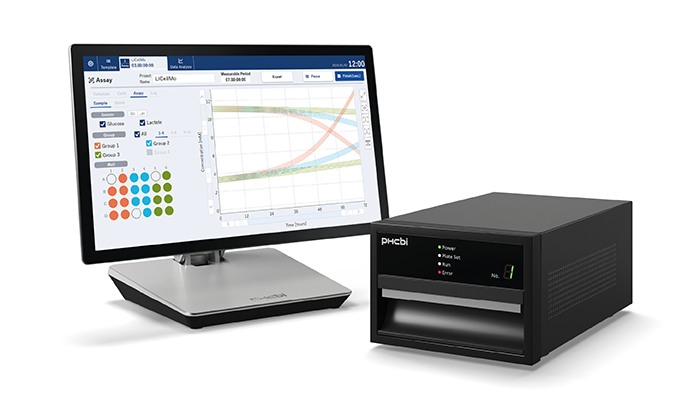
10 – LiCellMo (Live Cell Metabolic Analyzer)
Laboratory instrument allowing researchers to visualize changes in cell metabolism in real time
Produced by the Biomedical Division of PHC Corporation, a member of PHC Group
In cell and gene therapy (CGT) research, monitoring cell growth and optimizing the cell culture environment are crucial. LiCellMo offers real-time visualization of metabolic changes in cell cultures, giving researchers a comprehensive view of cell activity. Unlike traditional methods that rely on periodic sampling – prone to contamination and gaps in data – LiCellMo provides continuous minute-by-minute measurements of glucose and lactate levels.
What the judges say…
“Simply cool technology in cell monitoring!”
Meet the LiCellMo team
Here, we speak with the team behind LiCellMo – the Cell & Gene Therapy product team at PHC Corporation of North America (PHCNA):
- Brock Young – Technical Product Sales Specialist
- Tia Harmon, PhD – Technical Product Sales Specialist
- Cristie Marko – Technical Product Sales Specialist
- Kenan Moss – Application Specialist
- Ryosuke Takahashi – Vice President, Cell and Gene Therapy Business Development
What impact could your innovation have?
LiCellMo provides continuous monitoring of glucose and lactate in cell culture, giving researchers a precise picture of previously unobservable changes in the state of cells over time. By providing continuous and accurate metabolic data, LiCellMo will allow researchers to make more informed decisions. This may lead to key insights in metabolic research as well as improved manufacturing processes for the development of improved cell culture protocols which taken together could lead to more effective therapies.
Was there a key breakthrough during development?
The in-line monitoring technology featured in LiCellMo (Live Cell Metabolic Analyzer) builds on proprietary technology from a blood glucose monitoring sensor developed by another part of PHC Group, the In Vitro Diagnostics (IVD) Division.
The breakthrough for LiCellMo was when we realized we could use this BGM technology from the IVD business to develop a sensor for monitoring culture media. However, whereas BGM is a one-time measurement, this sensor needed to measure with high accuracy for two consecutive weeks. By adding a substance to the protective film of the sensor, we were able to significantly extend the measurement period. Through continued efforts, we created a sensor that combines high accuracy and durability.
Did you collaborate with any external teams during development?
LiCellMo is an internal company development, however it builds on technology developed by the IVD Division of PHC Group. We believe this synergy will give researchers the opportunity to gain unprecedented new knowledge on cell metabolism in the fields of cancer immunology and stem cell research, and in the manufacturing process for new treatments in those fields.
Do you have a “philosophy of innovation”?
Our team’s approach to innovation is that it should not only make processes more efficient, but also easier. The LiCellMo accomplishes both of these by providing continuous and accurate metabolic data, allowing researchers to make more informed decisions.
Are you driven more by scientific curiosity or the desire to make an impact?
The development of the LiCellMo was driven by impact. We seek to partner with researchers to provide precision healthcare technology where it is needed most, and we believe that continuous monitoring will lead to more effective Cell & Gene Therapy processes.
Is there anything missing from the analytical scientist’s toolbox today?
Continuous monitoring was previously missing from the analytical scientist’s toolbox. Conventional methods for evaluating cell metabolism require researchers to take periodic samples of the culture medium, which makes it difficult to monitor changes in cell conditions over time, as the measurements are typically discrete data points. Repeated sampling also carries the risk of contamination. Reproducibility issues can also occur in culture manipulation, as the standards for assessing cell states depend on the skill and experience of the researcher. Consequently, researchers need a method to continuously monitor the state of cells based on objective and quantitative assessment indicators without the need for repeated medium sampling.
What big problems could analytical innovation help to solve over the next decade?
Over the next decade, innovations such as LiCellMo can lead to more effective therapies to slow or stop the progression of disease.
What’s next for your team?
We are planning to launch another Cell & Gene Therapy product, LiCellGrow, a bioreactor currently under development that is designed to allow pharmaceutical companies to visualize continuous metabolic changes in cells in real-time and adjust the cell culture automatically to optimize conditions for cell growth. The system seeks to expand availability of Cell & Gene Therapy products by accelerating the manufacturing of specific cells needed for these therapies.




